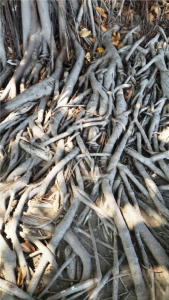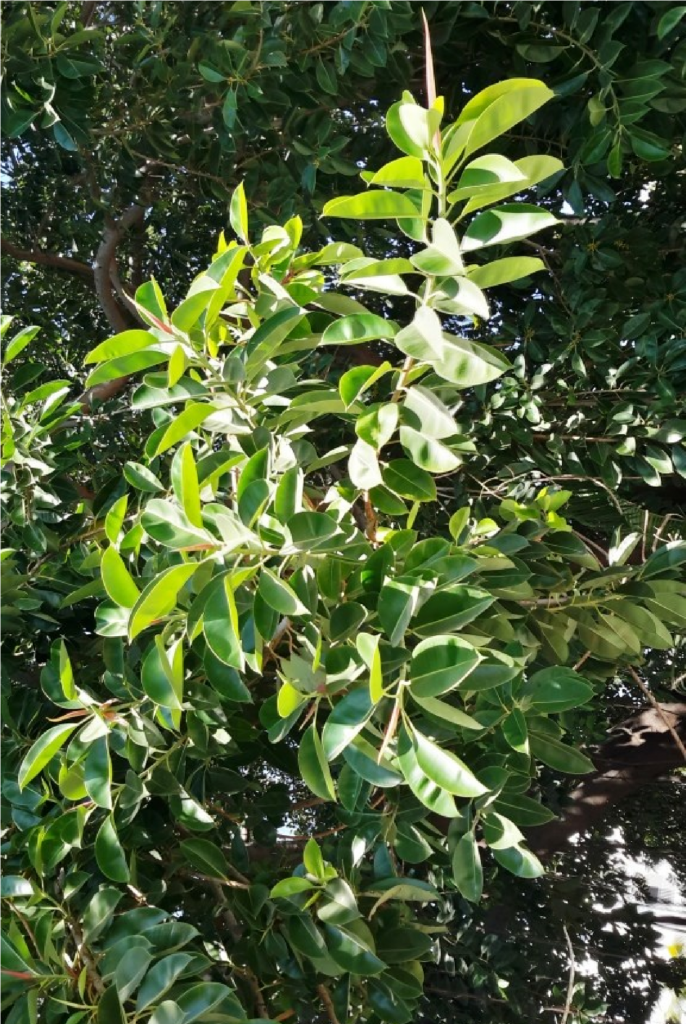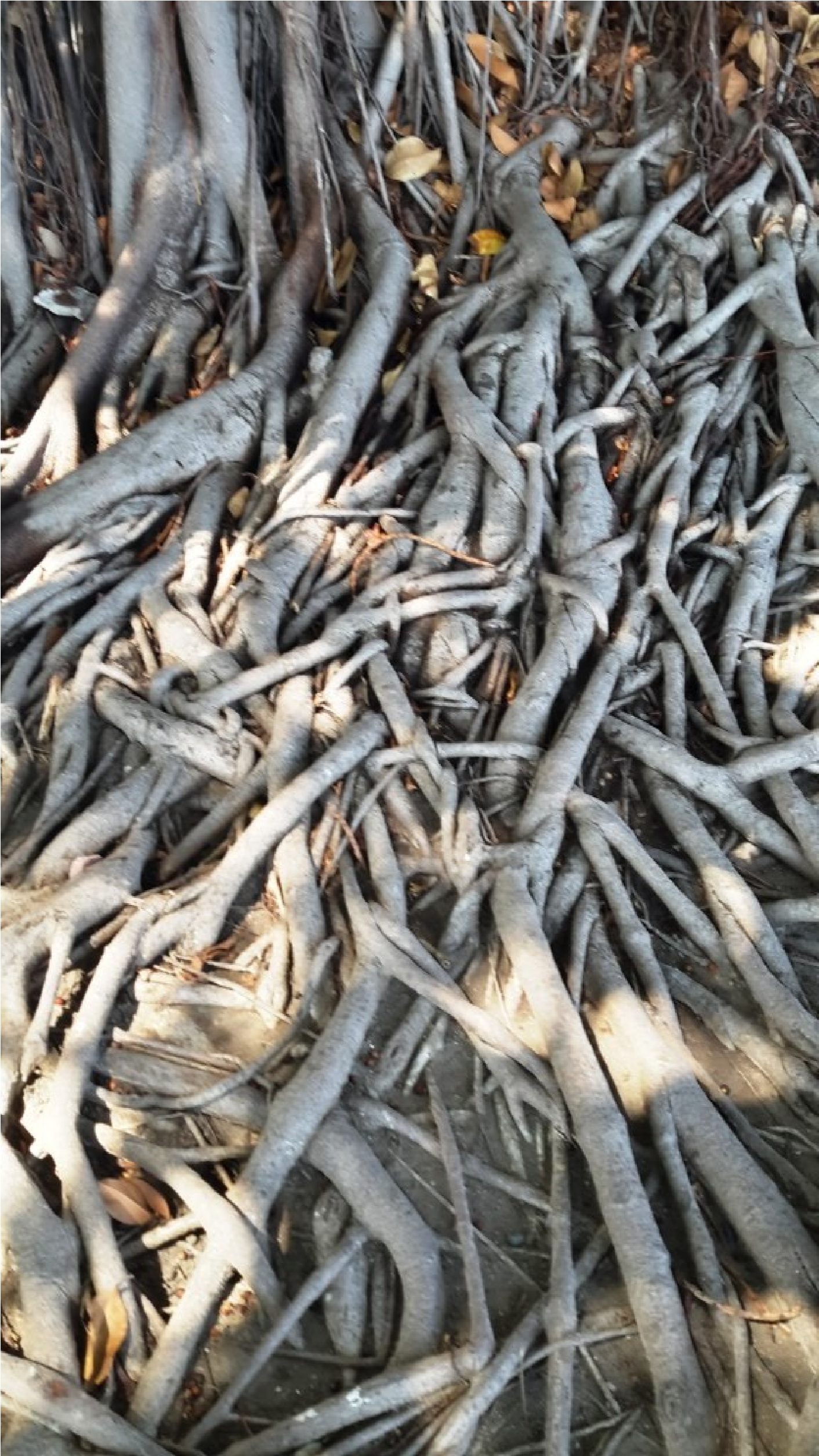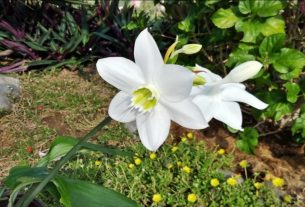By Tommy Clarkson on the June 2019 Edition
Indian Rubber Plant Ficus elastic
Family Moraceae
Also known as Indian Rubber Tree, Rubber Fig, Rubber Bush, Asssam Tree or Snake Tree
From a genus of no less than 800 species and a rather substantive group thought to be double that number by some botanists the strange growth and aberrant evolution of the Indian Rubber Plant to maturity is interesting.
It usually begins its life as an epiphyte. After a bit of time, however, without remorse or the slightest hint of guilt, over an ex-tended period of time, it lingeringly strangles its host in a torturous and (for my money) most sordid manner.
Having done so, it then evolves into a relentless, shadow skulking, night marauding…no, no, forgive me, my hyperactive imagination involuntarily kicked in during my plant description and got thoroughly confused with one of Sir Arthur Conan Doyle’s evildoers.
After honest to goodness choking its host plant, it then does evolve, but into a gigantic, banyan type fig, growing, potentially, up to 150 feet (45.72 meters). It has a massive, buttressed trunk covering a large area, with serpentine roots snaking every which way from the trunk, giant ascending limbs and a veritable sheet of aerial roots. To quote Robert Lee riffle, “(These) trees make not only a forest within a forest, but are also veritable worlds unto themselves . . . It is one of the noblest and most awe inspiring examples of tropical vegetation.”
 Its origin is the somewhat broad region ranging from India, through Myanmar, Sumatra and Java to Malaya. (Yes, even though I’ve lived and worked in that part of the world for four years, I, too, wasn’t altogether sure what that last one constituted or where it was. Devious sort that I am, I believe I’ll let you discern that location on you own!
Its origin is the somewhat broad region ranging from India, through Myanmar, Sumatra and Java to Malaya. (Yes, even though I’ve lived and worked in that part of the world for four years, I, too, wasn’t altogether sure what that last one constituted or where it was. Devious sort that I am, I believe I’ll let you discern that location on you own!
It should almost go without saying that such is the enormity of these trees that, as a rule, they don’t figure into a place in the normal backyard garden! But it is, truly, a wonder to behold! Somewhat a reflection of the great tree itself, its dark green on top with a glossy under surface one foot (30 cm) in length, elliptic to oblong leaves with their prominent, light-colored midvein are, in themselves, magnificent and an enjoyment to view and study!
These leaves are short stalked and, in the older trees, generally, found mostly at the branch ends. The tree’s leaf buds are covered with a pink to red colored stipule that like some unwanted visitors may linger long, well after the leaf emerges.
Yet, this only adds to the tree’s beauty and allure. (Getting back to that word “stipule” It refers to outgrowths borne on either one, or both, sides of the base of a leafstalk, which you might remember is the “petiole”.)
on either one, or both, sides of the base of a leafstalk, which you might remember is the “petiole”.)
Its light to dark green, oblong figs are approximately one-half inch (1.27 cm) in diameter. Its tiny flowers have no petals. The fruit is inside of a hollow, fleshy receptacle with a tiny opening through which insects enter and do the job that they were intended pollinate the flowers!
The Rubber Tree’s latex sap is thick and milky and not poisonous. It was once used in rubber making, as a substitute for the superior sap of the Hevea brasilienis.
The F. elastic ‘Decora’, ‘Doescheri’, ‘Schryvariana’ and ‘Tricolor’ cultivars are variegated forms but they don’t, necessarily, work well as good landscape specimens. Possible houseplants? Yes. Out of doors? No, probably not.
These days, one can find almost any number of plants, in nurseries, grocery stores and aside roads that are labeled “Ficus elastic”. It seems that almost every plant around aspires to be a Rubber Tree Plant! The cultivar names, by which they are known, vary greatly. It could be a tongue twisting mouthful such as the Foliis Aurio-marginata or as simple as a Burgundy, Rubra, Tricolor or, perhaps, an interesting sounding, Strawberry and Cream Rubber Tree Plant.
As for me, as concerns this plant and its many variations, I can’t help but always smile and have positive feelings upon seeing one. These stem from remembering the great lyrics as written by Sammy Cahn for the song “High Hopes” -sung by Frank Sinatra in the 1959 movie “Hole in the head” with this relative stanza, “Oops there goes another Rubber Tree Plant”! (I will save you from my actually singing it. But if you don’t remember the song, look it up. It’s a fun one!)
The full edition or view it online
—
Tommy Clarkson is a bit of a renaissance man. He’s lived and worked in locales as disparate as the 1.2 square mile island of Kwajalein to war-torn Iraq, from aboard he and Patty’s boat berthed out of Sea Bright, NJ to Thailand, Germany, Hawaii and Viet Nam; He’s taught classes and courses on creative writing and mass communications from the elementary grades to graduate level; He’s spoken to a wide array of meetings, conferences and assemblages on topics as varied as Buddhism, strategic marketing and tropical plants; In the latter category he and Patty’s recently book, “The Civilized Jungle” – written for the lay gardener – has been heralded as “the best tropical plant book in the last ten years”; And, according to Trip Advisor, their spectacular tropical creation – Ola Brisa Gardens – is the “Number One Tour destination in Manzanillo”.




